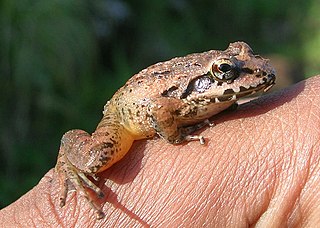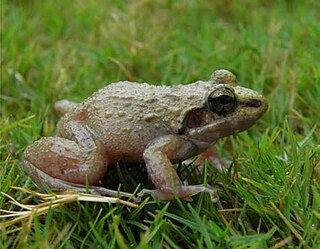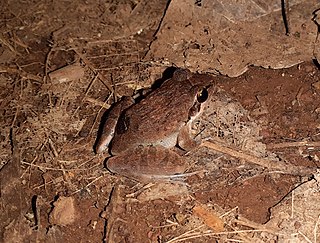
Indirana beddomii, Beddome's leaping frog, Beddome's Indian frog, or simply Beddome's frog, is a species of frog found in the Western Ghats. They are usually detected by their long leaps as they flush from the ground when disturbed. The species is named after the naturalist Richard Henry Beddome.

Indirana semipalmata is a species of frog endemic to the Western Ghats region of southern India. They are small frogs, reaching lengths of about 36 mm (1.4 in) from snout to vent. The species breeds during the monsoons, laying their eggs on moist rocks and tree bark. Their tadpoles are terrestrial – hatching, feeding, and undergoing metamorphosis without ever entering any standing bodies of water.

Indirana leithii is a species of frog in the family Ranixalidae. It is endemic to the northern Western Ghats of India. As currently defined, its range is restricted to the states of Maharashtra and southern Gujarat; earlier records elsewhere refer to other species.
Indirana gundia is a species of frog found in the Western Ghats of India. It is only known from its type locality, Kempholey, Karnataka. Indirana gundia is listed among "Top 100 EDGE Amphibians". It represents a family that has been evolving independently in India for almost 50 million years.
Walkerana leptodactyla is a species of frog endemic to the southern Western Ghats in Kerala and Tamil Nadu states of southern India. Precise reports are from Anaimalai hills, Palni hills, Meghamalai, Travancore hills and Agasthyamalai.

Walkerana phrynoderma is a species of frog endemic to the Anaimalai Hills, of the Western Ghats of Kerala and Tamil nadu states in southern India. This species is known from Munnar, Eravikulam National Park, Valparai tea gardens, Anamalai Tiger Reserve, Grass Hills National Park and Palni hills. It is a very rare terrestrial frog species associated with leaf-litter in tropical moist forest. It is threatened by habitat loss caused by subsistence wood collecting. It has the status of one of the "Top 100 Evolutionarily Distinct and Globally Endangered Amphibians."

Raorchestes signatus is a species of frog in the family Rhacophoridae. It is endemic to the Western Ghats, India.

Raorchestes kakachi is a species of frogs in the family Rhacophoridae. It is endemic to the southern Western Ghats of India. The specific name kakachi refers to the type locality from where the species was described.

Raorchestes kadalarensis is a species of frog of the genus Raorchestes found in Kadalar near Munnar in the Western Ghats of Kerala in India. This frog has been observed between 1300 and 1700 meters above sea level.
Raorchestes theuerkaufi is a species of frog of the genus Raorchestes found in the tea estates of Kadalar near Munnar, Idukki district, in the Western Ghats of Kerala in India. The species is named after Wolfgang Theuerkauf, a botanist and director of the Gurukula Botanical Sanctuary in Wayanad, Kerala.

Utham's tree frog is a species of frog of the genus Raorchestes found in Gavi, Pathanamthitta district, in the Western Ghats of Kerala in India. Scientists first observed it near, near a cardamom plantation in Gavi, 1000 meters above sea level. The species is named after two naturalists, bird photographer, P.K. Uthaman, and Deputy Conservator of Forests, K.V. Uthaman.

Indirana chiravasi is a species of frog endemic to the Western Ghats of India. It is only known from its type locality, the laterite plateaus by the hill-station of Amboli, Maharashtra. It was described in 2014 by a team of three scientists from IISER, Pune and MES Abasaheb Garware College.

Indirana tysoni, also known by its common name Tyson's leaping frog, is a species from the genus Indirana. The species was originally described in 2016 by Neelesh Dahanukar, Nikhil Modak, Keerthi Krutha, P. O. Nameer, Anand D. Padhye, and Sanjay Molur.

Roarchestes blandus or the Anamalai bush frog is a species of frog in the family Rhacophoridae. It is endemic to India. Scientists have observed it in the Western Ghat mountains, between 45 and 806 meters above sea level.
Ghatixalus magnus, the large-sized Ghat tree frog, is a species of frog in the subfamily Rhacophorinae. It is endemic to India, in the southern Western Ghat mountains, between the Palakkad Gap and Shencottah Gap.
Indirana salelkari, the Netravali leaping frog, is a species of frog in the family Ranixalidae. It is endemic to India's Western Ghat mountains.
Indirana paramakri, the rocky terrain leaping frog or Suganthagiri leaping frog, is a frog in the family Ranixalidae. It is endemic to Kerala, India in the Western Ghat mountains.
Indirana yadera, the Yadera leaping frog, is a frog in the family Ranixalidae. It is endemic to India's Western Ghat mountains.
Indirana sarojamma, or Sarojamma's leaping frog, is a species of frog in the family Ranixalidae. It is endemic to in Kerala, India in the Western Ghat mountains, south of the Palghat Gap.
Indirana duboisi, the Karnataka leaping frog or Dubois's leaping frog, is a frog. It is endemic to India in the Western Ghat mountains.












